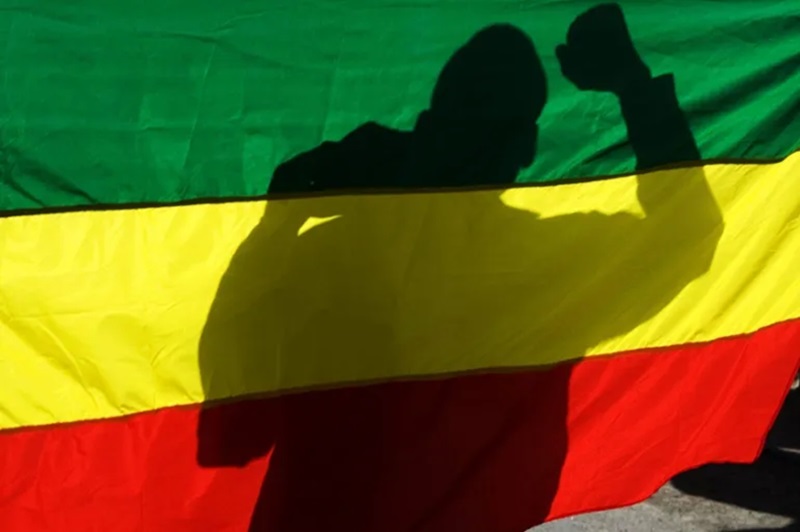By: Zerihun Abebe Woldeselassie, University of Bergen Norway
When they demolished the Derg-regime in the early 1990s, through a collation of ethnic or nationalist movements, the TPLF (Tigray Liberation Front) and EPLF (Eritrean Liberation Front) (and others) leaders had the impetuous dream of establishing peaceful and friendly countries through two short and long term plans. The short term plan was driven by the impulse to let Eritrea secede from Ethiopia while trying to make it legitimate in any way possible. This was expressed through a) the characterization of Eritrean question as colonialism against the existing academic consensus, and b) the immediate recognition of the Eritrean independence despite the fact that TPLF was not an elected or legitimate Ethiopian government at the time.
The long term but furtive plan was the obstinate desire to control, for some years to come, state power in Ethiopia and Eritrea using Ethnicity and nationalism as legitimizing ideologies. The Eritreans felling into the clutches of the EPLF can only be explained by the promotion of a nation-state style nationalist ideology by the EPLF in which ordinary Eritreans are told how they are different if not unique from other Peoples in the horn, especially from their former co-citizens, Ethiopians. And an independent Eritrean state, they were promised, would bring prosperity, welfare, democracy and peace. TPLF in its turn legitimized its state control in Ethiopia through ethno-nationalist ideology characterized by contradictory political moves. On the one hand this is accomplished by marginalizing and excluding other competing ethno-nationalist movements (such as the OLF) for various reasons, which I do not discuss in this paper. On the other TPLF has also legitimized its power by institutionalizing what many commentators characterize as pseudo-federal state system through the practice of encadrement in which the elites of the various ethnic groups in the country (which are now nation, nationalities and Peoples) are accorded access to state power and resources in as much as they are not subversive to the regime of power of the ruling elites.
To the dismay of some of the leaders as well as the majority ardent followers of the two parties, after almost 20 years of Eritrean independency and control of state power in Ethiopia and Eritrea, there is still no friendly or plausible relationship between the two. There are a number of developments that demonstrates this. The bloody war that broke out in 1998-2000, despite the fact that when TPLF and EPLF came to power, they arrogated to themselves the wisdom of establishing peaceful political orders, is major evidence. Not only the war claimed the lives of many human beings from both sides but also there is still a continued and erratic military raid and other incidents that show no avail.
For a neutral and critical observer the leadership of the two parties have so far preferred to avoid accountability by pointing finger on each other. The EPLF-led Eritrean leaders blame their TPLF-led Ethiopian counterparts for the latter failed to enforce the Algiers Agreement and the Boundary Commission ruling. The Ethiopian leaders in their part refused to allow this insisting that there should be further talks before any enforcement of the ruling of the Commission. Such dispute, however, doesn’t deal with the very basis of the conflict in the first place. It rather eschews those structural questions that should have been dealt, from the very outset, by responsible and rational political leaders who have a vision of democracy and rule of law rather than controlling and justifying their control of state power.
Looking into the current standoff and its undesirable situations it is fair to argue that rather than rushing into the business of expediting Eritrean session and controlling of state power, the TPLF-leadership, who claimed a self-proclaimed moral and legal authority of “liberating Ethiopian Peoples”, could at least have addressed the following main questions with their EPLF counterparts. First, was Hailsaelassie’s annexation of Eritrea 1962 and the subsequent union with Ethiopia colonialism? What is the consensus or suggested points regarding this by the existing majority academics? Second, how can we legally and politically maintain the interest of the two Peoples, in situation of session, in a way that doesn’t favor one at the expense of the other? Third, how can we incorporate the voices of the two peoples in such processes? Fourth, does EPRDF have a legitimacy of power to facilitate and officially recognize an independent Eritrea? Howe does that relate to the question of Ethiopian sovereignty? Neither TPLF nor EPLF had rational and scientifically supported explanations for such questions. I want my readers to understand that by raising such questions, I am not longing for the returning to the status quo ante bellum. The main point rather, though in hindsight, is to demonstrate that their inability to deal with such issues had in fact contributed to the contemporary failures of the TPLF and EPLF leadership.
Referring to the Eritrean case in his work entitled Nation Building, State Construction and Development in Africa, Andebrhan Welde Giorgis, recently (2010) argues that “the state in Eritrea, … has failed to provide for the needs, promote the wellbeing, cater to the aspirations and safeguard the security of the people. It is characterized by a crisis of legitimacy, delivery and relevance.” pp. 1. ”The promise to create a modern, advanced and competitive economy within two decades has failed to materialize, leaving the Eritrean economy in tatters.” pp.13. Such statements not only clearly imply that the very reality on the ground is far from what is envisaged or rather embellished by EPLF’s nationalist ideology but also indicates that the fundamental question is whether Eritrea is a viable state to its citizens without any good and friendly political and economic relations with its immediate neighbor, Ethiopia.
Regarding the Ethiopian situation, one recognized academics, J. Abbink (2009), in his recent article entitled The Ethiopian Second Republic and the Fragile ’Social Contract’, Africa Spectrum, 44, 2, wrote that – ”In post-1991 Ethiopia ethnic identities, mainly in the form of linguistic-cultural background and based on Stalin’s conception of “nationalities” (originally in his work The National Question and Marxism, 1914) were recognized politically and made the basis of regional and local administrations, to be filled by local people (often to the exclusion of so-called “non-natives” despite their job qualifications). As such this was a new answer to the problems of multi-ethnic Ethiopia, but the tensions between population groups on the national and local level were far from solved by it. Ethno-political competition emerged, also exclusionist discriminatory practices, and conflicts on power and budgets” pp. 13. The argument of Abbink clearly indicates that notwithstanding the recent economic growth, the controlling of state power through ethnic elites has only created a fragile political order that failed to solve ethnic tension and competition contrary to what the TPLF-led EPRDF leaders flaunt.
One shouldn’t therefore wonder why after a long history of “liberation” movement and coalition, the TPLF and EPLF “liberators” failed to create a lasting peace and stability in the region. I argue that rather than empowering the Peoples and negotiating at any cost to create peace and sustainable political order the real aim of the leaders was controlling state power and achieving their eccentric objectives. These objectives had varied nature that could be personal and collective, appealing to individual as well as group motives. In the mean time a number of unforeseen circumstances had in fact emerged and today’s situation needs a more wide analytical framework than stipulated here. Nevertheless, there is ample and clear indication that both TPLF and EPLF leadership had only pursued their respective interest against what is common to all Ethiopians or both Ethiopians and Eritreans.
This political behavior is still evident, for example in TPLF-leaders who do not have any clear agenda regarding what unites Ethiopia within one federal state. While TPLF leaders go great length to systematically attack and disparage the historical Ethiopian Nationalism, they have never put an equally significant positive effort to build a new, citizenship-based form of Ethiopian nationalism by identifying those shared values and symbols that unite all Ethiopians across ethnic and linguistic boundaries. In fact the TPLF leaders give trifling importance to such pan-Ethiopian agenda. Similar demeanor is still observed in EPLF-leaders who resorted to Machiavellian tactics in order to achieve their short-sighted end of holding to power, even if that is against the interest of Ethiopian or Eritrean people.
On the other hand the TPLF-led Ethiopian government now seems to have the firm stand that the only solution regarding Eritrea is negotiations which I suspect set to correct, if possible, past-mistakes by addressing any lingering issues and re-define the future political and economic relationship between the two Peoples. In its weekly publication A Week in the Horn, the Ministry of Ethiopian Foreign Affairs publish a briefing entitled “Talking, not shooting is the only choice for Eritrea” seems to imply this position by noting that “the Ethiopian Government still upholds its determination that the problems between Eritrea and Ethiopia can only be resolved through negotiations and dialogue”. http://www.mfa.gov.et/Press_Section/Week_Horn_Africa_Mar_16_2012.htm#3. Whether the two leaderships will come to a table and begin to sort out and discuss their issues to reach a rational and legal consensus regarding not only the border case, but also other vital matters that have greater implications to the lives of ordinary Ethiopians and Eritreans is not clear, at least to the near future. However, we now know for sure that the negotiation and dialogue, the TPLF-led EPRDF is now insisting should have been desired and pursued 20 years ago in good time and condition.
The question is therefore why they failed to do so? The evident explanation is that when they organized themselves based on ethnic or nationalist ideology and finally were able to succeed (because of in fact different factors) in removing the Derg-regime in the early 1990s, the TPLF and EPLF-leadership either didn’t have the competence or the will to consider the ramification of their agenda and practice on the various peoples of the region. Needless to say that the interest or foreign policy of global powers especially that of the USA had played their share in the establishment of EPLF’s and TPLF’s regime-of power directly or indirectly. Nevertheless, at the end of the day the elites of the two parties, as the main actors and decision-makers personalities cannot elude responsibility for the post-socialist predicament and plight of the Peoples of the region.
Had the elites of the two parties were visionary, competent, responsible and transparent, they could have dealt with the Ethio-Eritrean issue in a way different from what they did by consulting neutral academics and all other voices or stake holders that have been subsequently consciously marginalized and excluded from the very political processes. By doing this not only they could have possibly avoided the war and the current deadlock but also such excluded actors would have allied with them and share the responsibility and burden of building and bringing peace, democracy, the rule of law and development in that troubled region. In fact we could have seen a different political discourse or scenario than what we are witnessing now. Generally, what we are experiencing between Ethiopia and Eritrea is the unforeseen and embarrassing pitfalls of the elites of TPLF and EPLF leadership
The writer is a research Fellow at the University of Bergen, Norway and can be reached zwo041@uib.no















